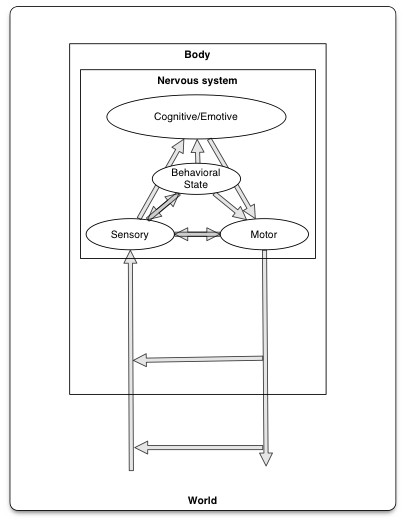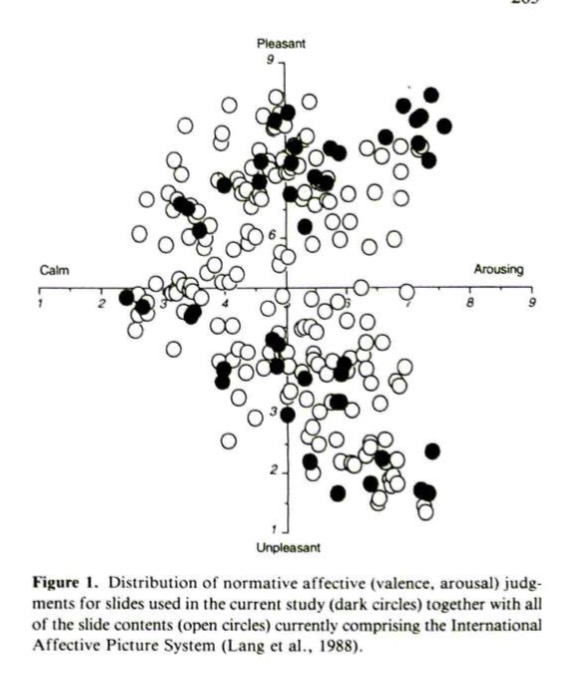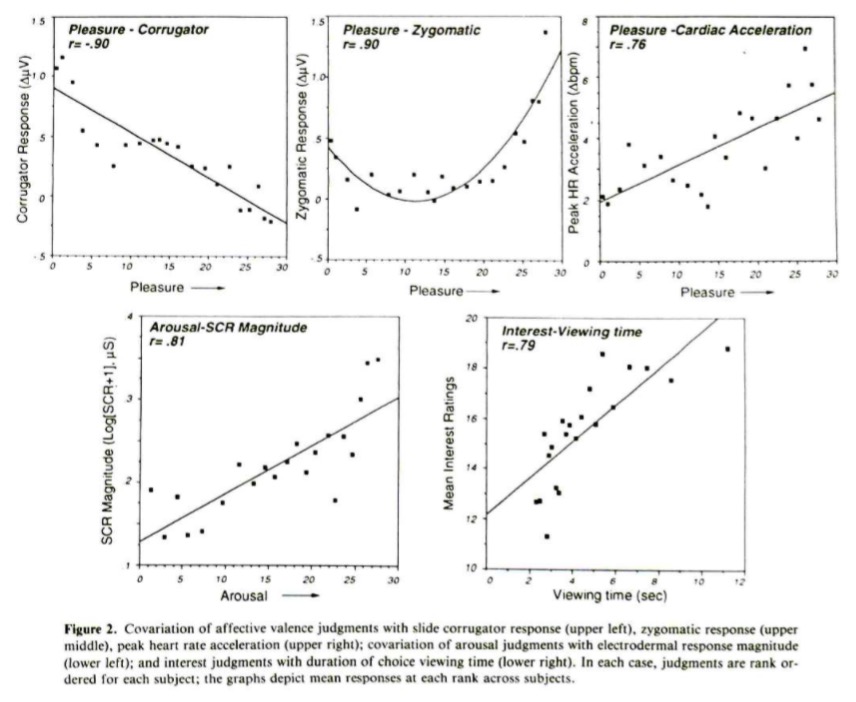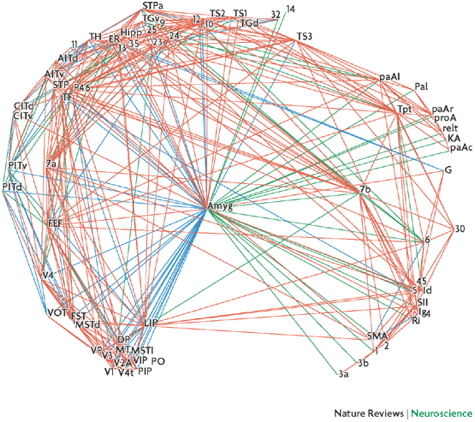2018-10-31 08:30:27
Prelude
Today's Topics
- Wrap-up on memory
- Biology of emotion
Biology of emotion
- Components
- Functional purposes
- Distal causes
- Proximal causes
- Dimensions and types
- Measurement
- Emotion == Cognition?
Components of emotion
- Physiological responses
- Autonomic
- Endocrine
- Subjective feelings
- Verbal responses
- Facial expressions
- Body movements
Distal causes
- Biological goals
- Ingestion, defense, reproduction, affiliation
- Emotions serve biological goals
- Approach/avoid or appetitive/aversive (Schneirla, 1959)
- Preservative vs. protective functions (Knorkski, 1967)
Distal causes

Proximal causes and effects
"Do we run from a bear because we are afraid or are we afraid because we run? William James posed this question more than a century ago, yet the notion that afferent visceral signals are essential for the unique experiences of distinct emotions remains a key unresolved question at the heart of emotional neuroscience."
Proximal causes and effects
- (William) James-(Carl) Lange
- Physiological response -> subjective feelings
- (Walter) Cannon-(Philip) Bard
- Severing CNS (spinal cord & vagus, esp SNS) from rest of body leaves emotional expression unchanged
- Physiological states slow, don't differentiate among emotions
Proximal causes and effects
- (Stanley) Schacter-(Jerome) Singer's Two-factor Theory
- Physiological arousal + cognitive appraisal -> emotional states
Dimensions
- Valence
- Positive/negative
- Intensity (arousal)
- Action tendency
- Approach/avoid
Types (Plutchik, 1980)

Measurement
- Autonomic Nervous System (ANS)
- Endocrine
- Brain activity
- Facial expression
- Subjective state
ANS measures of emotion
- Heart rate or heart rate variability (HRV)
- Galvanic skin response (GSR)
- Skin temperature
- Pupil dilation
- Electro-gastrogram (EGG)
Measuring heart rate variability (HRV)
- Variability in heart period (inter-beat interval, IBI)
- Respiratory sinus arrhythmia (RSA): variation in IBI due to respiratory inhalation/exhalation
- Sympathetic (SNS) and parasympathetic (PSNS) inputs converge on sinoatrial (SA) node of the heart
- Vagal (Xth cranial) nerve provides PSNS input
- Vagal tone: inferred effects of vagal/parasympathetic modulation of RSA (more vagal tone = more RSA)
Illustration of HRV

By Vivonoetics -
Own work, CC BY-SA 3.0, Link
HRV as a psychological measure
- IBI controlled by SNS and PSNS
- PSNS/vagal influences dominate @ rest, but are transient
- RSA (normally) declines with age
- Can measure SNS influence via impedance cardiography
- HRV and impedance cardiography are indirect measures of PSNS & SNS
ANS modulation of the heart

By Stevan Nikolin, Tjeerd W. Boonstra, Colleen K. Loo, Donel Martin - Nikolin S, Boonstra TW, Loo CK, Martin D (2017) Combined effect of prefrontal transcranial direct current stimulation and a working memory task on heart rate variability. PLoS ONE 12(8): e0181833. https://doi.org/10.1371/journal.pone.0181833, CC BY 2.5, Link
Covariance among ANS measures
"From the six ANS parameters studied, different autonomic patterns were identified, each characterizing one of the six basic emotion used as inducing signals. No index alone, nor group of parameters (EDR and thermovascular for instance) were capable of distinguishing each emotion from another. However, electrodermal, thermo-vascular and respiratory responses taken as a whole, redundantly separated each emotion thus demonstrating the specificity of autonomic patterns."
Biochemical measures
- Catecholamines (norepinephrine, epinephrine)
- Released by adrenal medulla following sympathetic nervous system (SNS) stimulation
- Sympathetic Adrenal Medullary axis
- Metabolites in urine or blood
Biochemical measures
- Corticosteroids (e.g., hydrocortisone or cortisol)
- Released from adrenal cortex into bloodstream
- Hypothalamic Pituitary Adrenal (HPA) axis
- Measured in blood, saliva, or hair
Diurnal corisol patterns
Cortisol as psychological measure
- Circadian periodicity
- Peaks around meal times
- Primary physiological role is modulating glucose & fat metabolism, anti-inflammatory
Do the measures cohere?
Are emotions 'natural kinds' distinguished by the brain?
- Or are emotions "…psychological events that emerge out of more basic psychological operations that are not specific to emotion." (Lindquist, Wager, Kober, Bliss-Moreau, & Barrett, 2012)
'Locationist' view

Fear: amygdala (yellow); Disgust: insula (green); Anger: OFC (rust); Sadness: ACC (blue). (Lindquist et al., 2012)
'Constructionist' view

Core Affect (pink): amygdala, insula, mOFC (Bas 10m, 11m, 13a, b, 14r, c), lOFC (BAs 47, 12, 13l, m, 11l), ACC (Bas, 32, 24, 25), thalamus, hypothalamus, bed nucleus of the stria terminalis, basal forebrain, PAG. Conceptualization (purple): VMPFC (Bas 11, 25, 32, 34), DMPFC (BAs 9, 10p), medial temporal lobe* (hippocampus, entorhinal cortex, parahippocampal cortex), posterior cingulate cortex/retrosplenial area (BA 23, 31). Language (green): VLPFC (Bas 44, 45, 46), anterior temporal lobe (BA 38); for additional regions, see Vigneau et al. (2006). Executive Attention (orange): DLPFC (BAs 9, 10, 46), VLPFC (BAs 44, 45, 46). (Lindquist et al., 2012)
Meta-analytic results
"James believed that emotions, thoughts, and memories are categories derived from commonsense with instances that do not require special brain centers. With respect to emotion, he wrote, “sensational, associational, and motor elements are all that [the brain] need contain” to produce the variety of mental states that correspond to our commonsense categories for emotion (cf. James 1890/1998, p. 473)…"
"James' view foreshadowed modern psychological constructionist models of the mind and the findings of our meta-analytic review, which are largely in agreement with this approach. Our findings are consistent with the idea that emotion categories are not natural kinds that are respected by the brain."
Emotions as distributed activation states
Emotions as distributed activation states
Questions
- Is emotional experience discrete/unidimensional?
- Are physiological responses (ANS, endocrine, brain activity)?
Is emotion different from cognition?

(Swanson, 2012)
Is emotion different from cognition?
(Pessoa, 2008)
"Here, I will argue that complex cognitive–emotional behaviours have their basis in dynamic coalitions of networks of brain areas, none of which should be conceptualized as specifically affective or cognitive. Central to cognitive–emotional interactions are brain areas with a high "degree of connectivity, called hubs, which are critical for regulating the flow and integration of information between regions."
(Nummenmaa, Hari, Hietanen, & Glerean, 2018)
(Nummenmaa et al., 2018)"Our data provide a detailed map of the human feeling space, where subjective feelings were strongly coupled with bodily sensations, and nearly all subjective experiences were qualified by emotional tone. Subjective states were best described on a 2D map with five distinct feeling clusters. Representational similarity analysis revealed strong correspondence between the mental feeling space and the corresponding bodily sensations, basic dimensions of subjective experience, as well as similarity between neural and bodily sensation maps across different subjective feelings. Altogether these findings show that feeling states are categorical, emotional, and embodied."
References
Chan, S., & Debono, M. (2010). Replication of cortisol circadian rhythm: New advances in hydrocortisone replacement therapy. Ther. Adv. Endocrinol. Metab., 1(3), 129–138. https://doi.org/10.1177/2042018810380214
Collet, C., Vernet-Maury, E., Delhomme, G., & Dittmar, A. (1997). Autonomic nervous system response patterns specificity to basic emotions. J. Auton. Nerv. Syst., 62(1-2), 45–57. Retrieved from https://www.ncbi.nlm.nih.gov/pubmed/9021649
Harrison, N. A., Gray, M. A., Gianaros, P. J., & Critchley, H. D. (2010). The embodiment of emotional feelings in the brain. J. Neurosci., 30(38), 12878–12884. https://doi.org/10.1523/JNEUROSCI.1725-10.2010
Knorkski, J. (1967). Integrative activity of the brain: An interdisciplinary approach. Chicago: University of Chicago Press.
Kragel, P. A., Knodt, A. R., Hariri, A. R., & LaBar, K. S. (2016). Decoding spontaneous emotional states in the human brain. PLoS Biol., 14(9), e2000106. https://doi.org/10.1371/journal.pbio.2000106
Lang, P. J., Greenwald, M. K., Bradley, M. M., & Hamm, A. O. (1993). Looking at pictures: Affective, facial, visceral, and behavioral reactions. Psychophysiology, 30(3), 261–273. https://doi.org/10.1111/j.1469-8986.1993.tb03352.x
Lindquist, K. A., Wager, T. D., Kober, H., Bliss-Moreau, E., & Barrett, L. F. (2012). The brain basis of emotion: A meta-analytic review. Behav. Brain Sci., 35(3), 121–143. https://doi.org/10.1017/S0140525X11000446
Nummenmaa, L., Hari, R., Hietanen, J. K., & Glerean, E. (2018). Maps of subjective feelings. Proceedings of the National Academy of Sciences of the United States of America, 115(37), 9198–9203. https://doi.org/10.1073/pnas.1807390115
Pessoa, L. (2008). On the relationship between emotion and cognition. Nature Reviews Neuroscience, 9(2), 148–158. https://doi.org/10.1038/nrn2317
Plutchik, R. (1980). Emotion: A psychoevolutionary synthesis. Harpercollins College Division.
Schneirla, T. C. (1959). An evolutionary and developmental theory of biphasic processes underlying approach and withdrawal. http://psycnet.apa.org/psycinfo/1960-05385-003; psycnet.apa.org. Retrieved from http://psycnet.apa.org/psycinfo/1960-05385-003
Swanson, L. W. (2012). Brain architecture: Understanding the basic plan. Oxford University Press.







